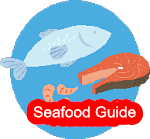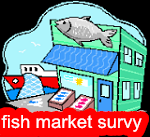From the interview we found that Mr. Guang-chao Tsou created the “Seafood Guide” so consumers can follow the guide when purchasing fish. Therefore, we realized that to save marine life we must start from the consumers; encouraging them to buy, to eat, and to choose the right type of fish, and also buy seafood in accordance to the criteria of the “green seafood”. To do all this and reinforce marine conservation awareness, we can save today’s marine life.
Why is there a need for the “Seafood Guide”?
For the past few years, conservation groups have been promoting Eco-label food by starting from the consumers; by buying seafood that comply with the “Seafood Guide”, eating the right fish, eating only seafood that comply with the criteria of “green seafood”, and reinforcing marine conservation awareness. Consumer’s choices of fish affect marine life, because of the seafood we buy only a small portion of it complies with the concept of sustainable marine resources. Things should change. Consumers beware. After all, no buying and selling equals no killing.
- Think clearly—suggest seafood lovers to think about whether they really have to eat this type of seafood. The catching and culturing methods for this type of seafood, and the fisheries management system is not complete. Furthermore, an increase in consumption of this type of fish would pose a threat to their existence, hence destroy marine environment.
- Don’t eat—this type of fish has been over fished. Using fishing or culturing methods that destroy marine ecology. Insufficient management of the fishery. There were fishes that were already listed in the endangered list. The continue consumption of this type of fish would destroy marine environment. Seafood lovers please stop eating this type of fish.
“Taiwan Seafood Guide” (In reference to “Taiwan Seafood Guide”, Fish Ecology and Evolution Research Center, December 2011)
During the holidays we went to the fish market with our families, and interviewed the people there with the following questions:
1. For the past few years is there a significant change in the supply of fishes?
2. For the past few years is there a change in the size of the fishes supplied?
3. For the past few years what type of fish were fished?
4. Do you (fishmongers) follow the Seafood Guide when giving your consumers suggestion on the type of fish to buy?
5. What type of fish would you suggest your consumers buy?
6. What type of fishes do most customers buy?
7. Do your customers buy according to the suggestions of the Seafood Guide?

We discussed with our family in accordance with the Seafood Guide on the type of fish we should buy? For the past one month following the “suggest consumption” list on the Seafood Guide, we bought clams, abalones, and scallops. But there were also times that we bought grouper, white pomfret and bass from the “think clearly” list. It was not easy following the Seafood Guide, but our families and we tried our best to comply. Hopefully this would help with the improvement of marine ecology and let more fishes be categorized into the “suggest consumption” list.
Results from interviews with the fishmongers shows that the most consumed fishes were white pomfret, Japanese butterfish, and tilefish. Of the above list, Japanese butterfish, and tilefish were listed in the “think clearly” list of the Seafood Guide, and since most of the consumers and fishmongers were not aware of this fact, a lot of people still buy them. Fish price is the highest in December and the cheapest in June and July. However, the price of fish in general has increase. Many fishmongers noted that the supply of fishes has decreased; such as the glass eyed perch. It has increased in price and the current price is about three to four hundred dollars NT in comparison to the past price of less than one hundred dollar NT. The quantity of fish supply depends on the season. There is more in the summer and less in the winter. On top of that, the fishmongers also noted that they notice a decrease in the size of most fishes.
Almost none of the consumers we interviewed know about the “Seafood Guide”. Therefore we handed out some pamphlets to the fishmongers and fish buyers. After this trip we’ve realized the importance of the “Seafood Guide”, because our choice on the consumption of seafood will affect marine ecology. We feel an urgent need to promote the “Seafood Guide”
2013estmuegifted18 / 1024x768










